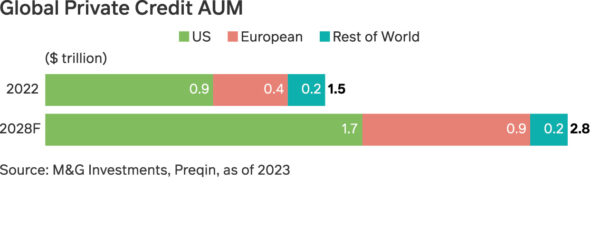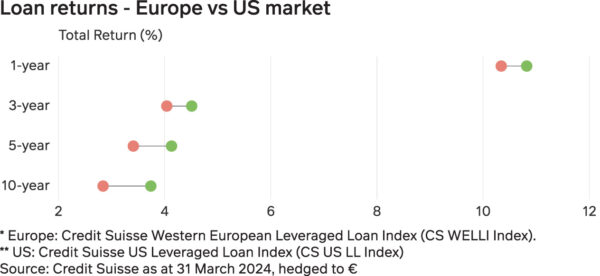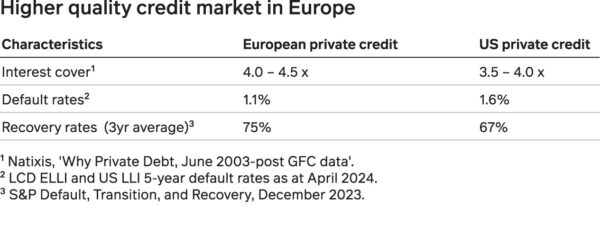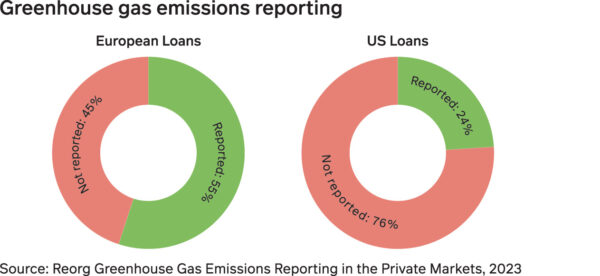By Aramide Ogunlana, Investment Specialist Director, Private Credit at M&G Investments
Investors’ appetite for private credit shows no signs of abating, with estimates suggesting it will double in value over the next five years. M&G Investments argues that the attractions of the asset class remain as strong as ever: potential inflation protection, diversification, potentially attractive risk-adjusted returns, and volatility reduction. But within the asset class, choices need to be made. Not least, with Europe and the US dominating almost 90% of the market¹, what are the key differences between these regions and where should investors set their focus?
Within the sub-IG corporate lending market, the more mature $3.5 trillion US market dominates being three times larger than the European market2. This differential narrows however within the private credit market where the US is only twice as large3.

Interestingly, as the above chart shows, whilst the overall private credit market could be set to almost double within the next 5-years, in relative terms, Europe could grow faster than the US.
In our opinion, a strong driver for this European growth will likely come from a narrowing of the disparity between Europe and the US sources of funding. In the more mature US private credit market, almost 80% of lending is provided by capital markets – in Europe this is only 30%.4 With the growing maturity of the European market, we believe this gap will close with capital markets (private credit) progressively accounting for an ever larger overall share of lending.
The European market is less developed than the US in terms of its size and degree of competitiveness in terms of number of participants. However its likely expansion will provide opportunities for investors seeking to capitalise on the growth opportunity. An enlarged private credit market in Europe offers origination opportunities, in particular for asset managers with a history and proven expertise within local jurisdictions.
Europe: Stronger returns for less risk?
The US market may be more mature than Europe, but greater maturity typically affects key risk and return characteristics. With the US being more mature, it is also a more competed market for lenders – there are a greater number of private credit lenders in the US versus Europe. This highly competitive US market typically lowers the yield available for investors.

These lower US margins are coupled to an overall lending environment demonstrating heightened risk characteristics relative to Europe. Indeed, most recently the European market has provided attractive spreads whilst also providing higher interest cover and lower default rates. Whilst there has been some convergence recently, historically in Europe companies have also tended to have more conservative equity cushions.

In terms of the legal environment, whilst the European market is more ‘lender friendly’, it is more complex to navigate due to fragmented legal jurisdictions versus the singular jurisdiction within the US.
Downside protection: The value of collaboration
A key distinction between the European and US private credit markets are both the legal remedies available and lender characteristics within different European jurisdictions. The prime difference is the existence of the Chapter 11 bankruptcy mechanism within the US, which provides companies and distressed borrowers a more immediate and formal route to enact work-outs. Europe is characterised by many local restructuring regimes and security jurisdictions, albeit these are by and large more creditor friendly than chapter 11, but still require greater collaboration between all parties in a workout situation to come to a resolution.
Being multiple jurisdictions, each with distinct lender-friendly characteristics, makes navigation of the European market more complex. However, this diversity often demands a higher level of expertise by lenders, so specialist knowledge from asset managers is an important capability to have.
The emergence of the European retail investor?
Perhaps due to the increased maturity of the US market, retail investors are a feature in the US whilst being largely absent in Europe. This is a positive and a negative. On the one hand retail participation increases the addressable investor base, on the other, the presence of retail investors likely heightens volatility within US private credit markets.
A catalyst for greater European retail participation will likely be driven by the growth of European Long Term Investment Funds (ELTIF), established in 2015. The ELTIF provides an accessible, retail-friendly structure allowing individuals to benefit from the same private market opportunities previously the reserve of institutional investors. Retail investors have the potential to benefit from both diversification and attractive risk-adjusted returns.
European retail investors are likely to be attracted to the widening opportunity set emerging in European private credit. The previously discussed growing maturity of the European market, historically higher returns, better credit quality and greater credit opportunities with continued retrenchment in lending by European banks, provides a highly appealing alternative investment choice for individuals, in our opinion.
ESG integration: Europe leading the way
Europe is significantly more advanced, both in terms of ESG integration and disclosure, than the US. For investors this matters as ESG factors are risk factors. Assessment of any risk which might impair the ability of a lender to repay their debt is clearly key. Risks associated with ESG factors can be financial, reputational or regulatory. All can pose a detrimental threat to credit quality and a company’s ability to service or repay its debt.

Given Europe has embraced ESG integration over a longer period than the US, the European approach is more advanced and credible. An issue facing investors across both regions however is the quality and reliability of data. This has been a perennial problem and one which has led many managers to establish their own proprietary research capabilities. Despite this, investor demand for deeper ESG evaluation and disclosure is only going to grow.
The private credit universe remains a highly attractive choice for investors across both the European and US markets. However, there are important characteristics which differentiate these two regions. The more mature and highly competitive US market may be larger, but evidence suggests that the risk is higher, credit quality lower and investors likely to obtain lower risk-adjusted returns relative to Europe.
For these reasons, M&G believe that the European private credit market, offering higher returns with less risk, should be the preferred destination for investors.
Footnotes:
1M&G Investments, 31 Dec 2023
2M&G Investments, 31 Dec 2023
3Preqin, 31 December 2023
4Oliver Wyman ‘The EU Banking Regulatory Framework, 2023’
ELTIFs are illiquid in nature because their investments are long term. For investors, this is an investment that has low liquidity. ELTIFs may not be suitable for Investors that are unable to sustain such a long-term and illiquid commitment. Only a small part of a portfolio should be invested in an ELTIF.
For Investment Professionals only. The value of investments will fluctuate, which will cause prices to fall as well as rise and investors may not get back the original amount they invested. The views expressed in this document should not be taken as a recommendation, advice or forecast. Past performance is not a guide to future performance.



